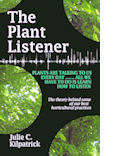Plant a Native Hedge
Leylandii hedges are boring, uniform and way too much trouble to keep in good condition. That's just my opinion but I bet its an opinion shared by many others.
All too often folk buy leylandii hedging believing it to be a cheap and quick way to get their boundary established. But this is not necessarily true. You can buy native hedging plants at a comparable price and size to leylandii plants and many will establish quite quickly.
One of my first gardening jobs was to regularly hand weed beneath a hawthorn hedge in a wildlife garden, weeding out the rough grasses and leaving alone the wildflowers so I can testify to the fact that, while leylandii strips the surrounding area of nutrients and does not allow anything to grow beneath it, native hedges can support, not just hedgehogs but all kinds of plants, pollinators, birds, mammals and amphibians.

In fact, according to the Tree Council, "over 600 plant species, 1500 insect species, 65 birds and 20 mammal species have been recorded as living in hedges". They have even been called Britain's largest nature reserve. Garden hedges can represent an important corridor for wildlife - a safe haven, or roadway, through which they can travel, sheltered from predators and humans. On top of that, in many of our native species, you get seasonal changes - either through flowers, berries or autumn leaf colour.
You can plant just one species or you can mix it up a bit and plant two or more species within the same hedge. This allows you to get more than one benefit from your native hedge. Here's a list of favourites for you to choose from:
For autumn colour
Beech (Fagus sylvatica); Field Maple (Acer campestre); Hazel (Coryllus avellana); Dogwood (Cornus sanguinea); Spindle (Euonymus europaeus); Guelder Rose (Viburnum opulus); Hornbeam (Carpinus betulus).

For flowers, fruits and nuts
Hazel (Coryllus avellana); Spindle (Euonymus europaeus); Guelder Rose (Viburnum opulus); Blackthorn (Prunus spinosa); Dog Rose (Rosa canina); Field Rose (Rosa arvensis); Yew (Taxus baccata). Also worth mentioning are those non-natives that produce berries for birds: Cotoneasters (Cotoneaster lacteus; Cot. franchetii; Cot. simonsii); Snowberry (Symphoricarpos albus laevigatus)and Firethorn (Pyracantha sp.)
As a burglar deterrent
Blackthorn (Prunus spinosa); Dog Rose (Rosa canina); Field Rose (Rosa arvensis); Firethorn (Pyracanths sp); Holly (Ilex aquifolium); Gorse (Ulex europaeus). Also the non-natives Firethorn (Pyracantha sp.) and Berberis (Berberis darwinii) both good burglar deterrents and producing flowers and berries for wildlife.
Evergreen natives
Yew (Taxus buccata); Holly (Ilex aquifolium)

You can buy your hedging plants container grown - in which case, you will usually plant a single row - or as whips (young bare root plants) - in which case you will usually plant a double, staggered row. Whips are generally much cheaper to buy than container grown but are usually only available in autumn as that is the best time to plant them.
- Consult your neighbours first. There's nothing to stop you planting a hedge on your own land but its always best to talk to your neighbours to avoid arguments.
- Measure the total length in metres and allow 5 plants per metre for bare rooted whips. Plant whips in a double, staggered row.
- Never plant when the soil is waterlogged and never plant when soil is very dry.
- Mark out the line of your hedge with two string lines for a double row and one for a single row.
- Soak the roots before planting
- Remove any dead, damaged or diseased branches before you plant
- Digging a trench is sometimes easier than digging individual planting holes. It also allows you to add composted material to the base of the trench
- Don't plant too deep - to the depth of the original soil level of the plant is perfect
- For bare root whips, give the plant a shake after you have added some soil around the roots to reduce air pockets
- Firm around the plant with your heel. Leave the soil level, or just slightly raised, when you have finished. You don't want water to collect around the base of the plant.
- Water well after planting and do not allow the soil to dry out in the first season
- Feed in spring with a general purpose fertiliser
- Prune regularly as required but not during the nesting season
Julie is editor of Gardenzine and author of The Plant Listener
Beech hedge image by Anne Burgess via wikimedia commons






